Linen is the original biotextile and it is produced through the interaction of plants, bacteria and engineering. As such, it has been used frequently in Dumitriu’s work as a metaphor for biotechnology and also as a means of exploring the relationship of environmental microbiology and infectious disease. Works in the series incorporate a range of media including textiles, sterilised bacteria and DNA, embroidery, wood, flax, ceramic, resin, and human hair.
- Skip to “Pastorianum“
- Skip to “Spindle“
- Skip to “Clean Linen“
- Skip to “The Art and Science of Linen“
From the Field – Exhibition at the Linen Biennale of Northern Ireland
A solo exhibition by Anna Dumitriu took place at R-Space Gallery in Lisburn and ran from 1st August to 7th September 2018 (Tuesday to Saturday, 11am to 5pm) as part of the Linen Biennale Northern Ireland. The exhibition brought together new and existing works exploring the relationship of microbiology and linen.
The title of the exhibition references the original name of the first nitrogen fixing bacterium, discovered by Sergei Winogradsky who was obsessed with the retting of flax: Clostridium Pastorianum, which translates to ‘spindle from the field’, the process of ‘field work’ in science, and notion of a ‘field’ as a disciplinary boundary, something that Dumitriu constantly transgresses by moving seamlessly between fine art, biology and craft.
List of Works
Pastorianum
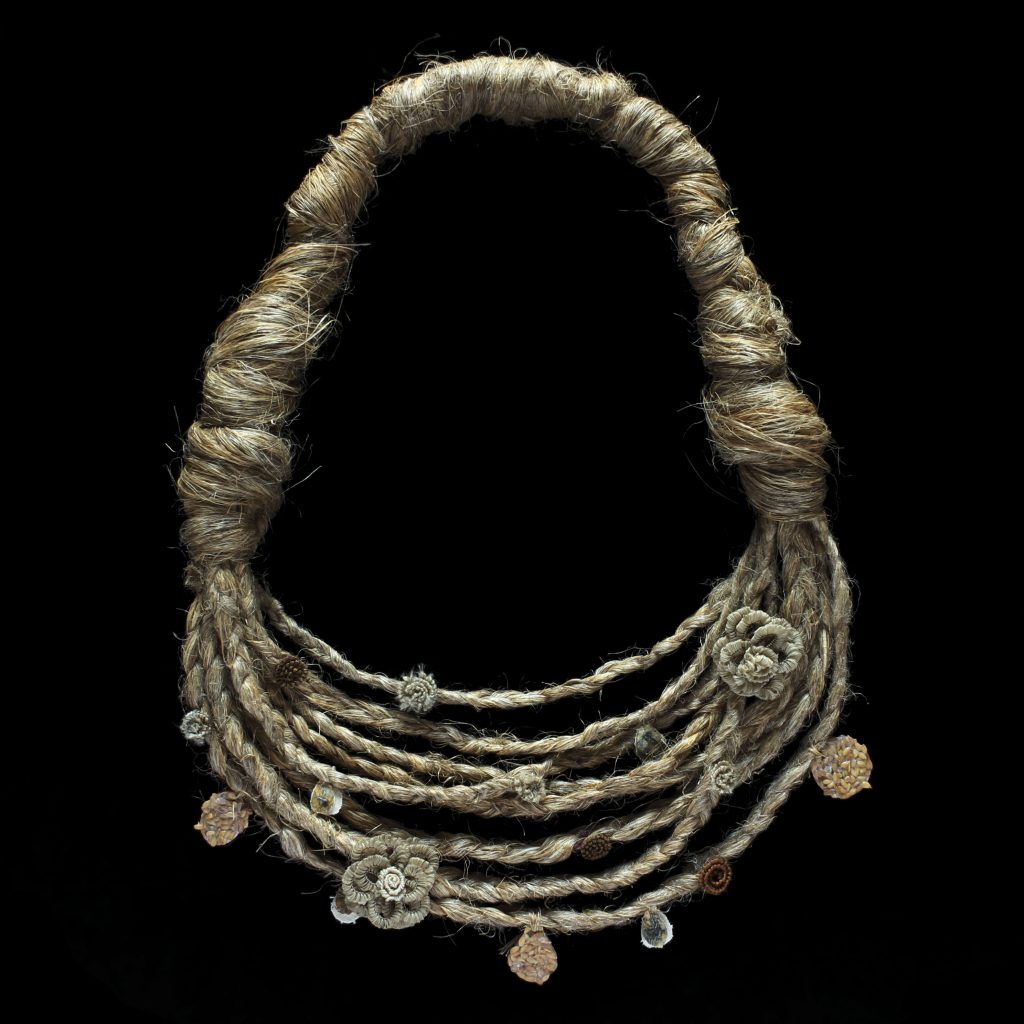
“Pastorianum” (2018) responds to the mythology around linen and explores bacteria responsible for the retting (rotting) of flax, a key part of the manufacturing process of linen. The work takes the form of a necklace woven together from unspun natural flax, antique human hair wreathes, glass beads containing Clostridium pasteurianum bacteria, beads made from resin and linseed, Irish linen lace and embroidered cloth impregnated with Clostridium difficile bacteria and mud from a captive bacterial ecosystem known as a Winogradsky Column.
Pioneering microbiologist Sergei Winogradsky was obsessed with the retting of flax, the process by which flax fibres are separated from the plant stems. He believed this to be caused by bacteria and finally succeeded in isolating a bacterium from the genus clostridium responsible for this process. He named the first nitrogen fixing bacteria Clostridium pastorianum which translates to ‘spindle from the field’ but the name was later changed to Clostridium pasteurianum in honour of his colleague Louis Pasteur. It is part of the species known as Clostridia which also includes the disease causing ‘superbug’ Clostridium difficile.
“Pastorianum” was made in collaboration with Kevin Cole and Professor John Paul, Modernising Medical Microbiology, and Dr Jane Freeman and Dr Caroline Chilton, The Healthcare Associated Infection Group at the University of Leeds.
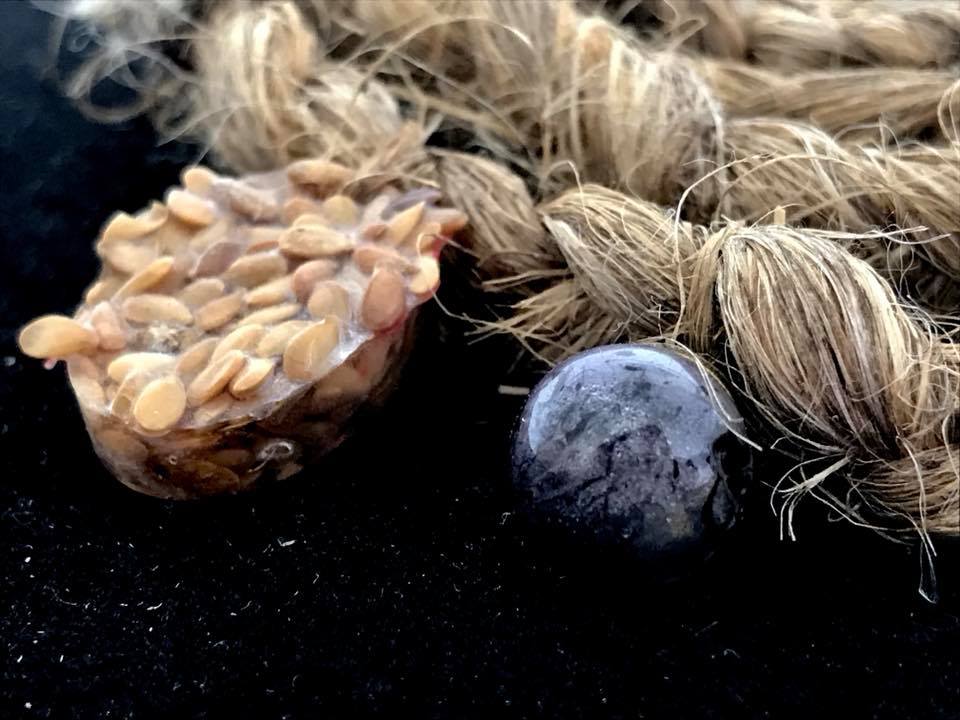
Pastorianum Exhibitions
From the Field at R- Space, Lisburn, Norther Ireland. As part of the 1st International Linen Biennale curated by Robert Martin. 1st August – 7th September 2018.
ReShape at MU Artspace in Eindhoven, Netherlands. Curated by Angelique Spaninks and William Myers. 30th November 2018 until 10th March 2019
“BioArt Alchemy” solo exhibition at Spazju Kreattiv in Malta, 16th September 2022 – 30th October 2022.
BioArt Revolution/ Revoluția BioArt, an innovative solo exhibition by Anna Dumitriu which took place as part of Timișoara 2023 European Capital of Culture, from 30th September to 1st October 2023. The exhibition, which was created in collaboration with the Romanian Science Festival, at Bastionul Maria Theresia, Galeria 2, Str. Hector, nr. 1, Timișoara, Romania.
BioArt Knowledge: A Solo Exhibition by Anna Dumitriu at the Yarrow Gallery in Oundle, Near Peterborough, UK, from 9th November – 6th December 2023.
Fragile Microbiomes (solo exhibition) at the Thackray Museum of Medicine, Leeds, UK, from 10th February to 23rd June 2024.
Spindle
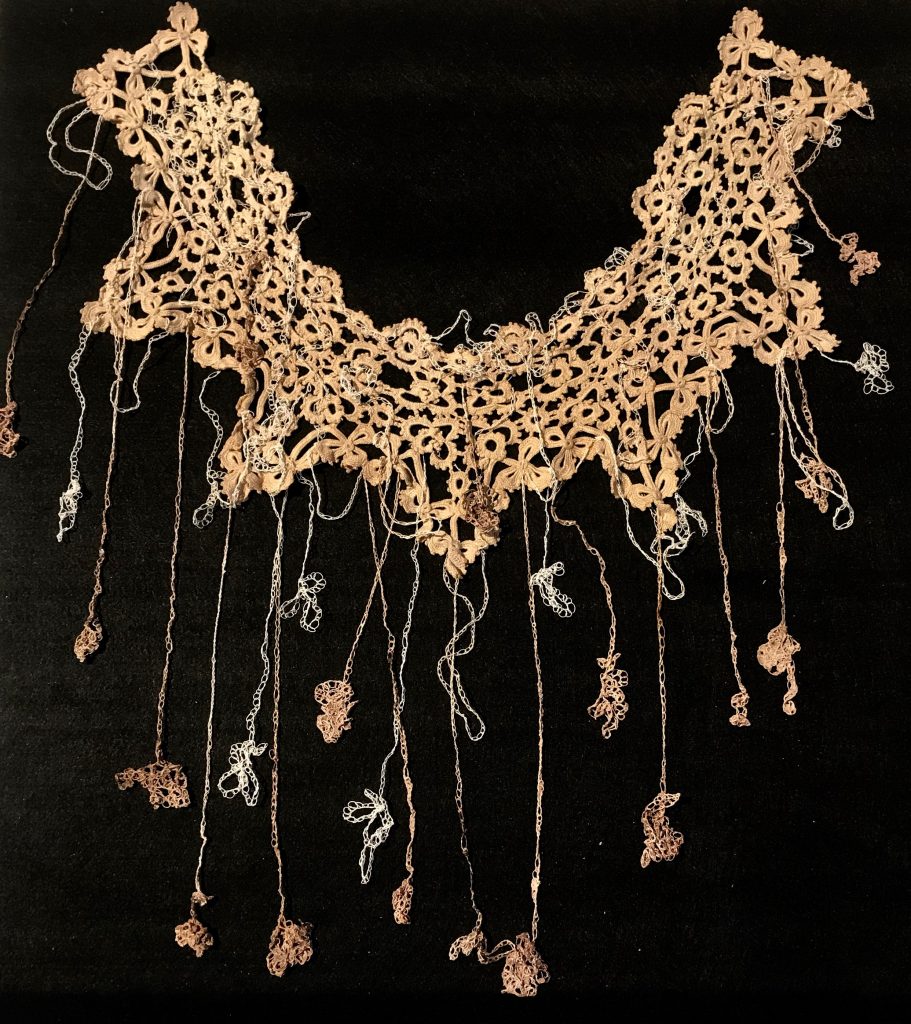
In “Spindle” (2018) three-dimensional solid sculptural appendages, which resemble drop spindles, have been created using the interaction between crocheted linen lace and biofilm producing bacteria from the human gut including spindle shaped Clostridium difficile. These are threaded into an antique linen lace collar.

When flax is retted (rotted), bacteria, including bacteria from the genus known as Clostridium swarm over the plant stems and help to separate the fibres often creating bacterial biofilms which help the microbes cling together. In disease-causing Clostridium difficile bacteria these biofilms form in the human gut make the bacteria harder to treat. Clostridia can also form spores that are resistant to antibiotics. Clostridium translates to spindle.
Made in collaboration with Dr Jane Freeman and Dr Caroline Chilton, The Healthcare Associated Infection Group at the University of Leeds.

Spindle Exhibitions

From the Field at R- Space, Lisburn, Norther Ireland. As part of the 1st International Linen Biennale curated by Robert Martin. 1st August – 7th September 2018.
ReShape at MU Artspace in Eindhoven, Netherlands. Curated by Angelique Spaninks and William Myers. 30th November 2018 until 10th March 2019
“Children of Prometheus” at NeMe in Limassol, Cyprus. Curated by Marc Garrett (Furtherfield). 11th October – 20th December 2019.
“BioArt Alchemy” at Spazju Kreattiv in Malta, 16th September 2022 – 30th October 2022.

BioArt Revolution/ Revoluția BioArt, an innovative solo exhibition by Anna Dumitriu which took place as part of Timișoara 2023 European Capital of Culture, from 30th September to 1st October 2023. The exhibition, which was created in collaboration with the Romanian Science Festival, at Bastionul Maria Theresia, Galeria 2, Str. Hector, nr. 1, Timișoara, Romania.
BioArt Knowledge: A Solo Exhibition by Anna Dumitriu at the Yarrow Gallery in Oundle, Near Peterborough, UK, from 9th November – 6th December 2023.
Fragile Microbiomes (solo exhibition) at the Thackray Museum of Medicine, Leeds, UK, from 10th February to 23rd June 2024.
Spindle II

In “Spindle II” (2022) is a later work which builds on the series and takes the form of three-dimensional solid sculptural appendages, which resemble drop spindles, have been created using the interaction between crocheted linen lace and biofilm producing bacteria from the human gut including spindle-shaped ‘superbug’ Clostridioides difficile. These have been twisted onto an antique French linen spindle. Linen is made from the flax plant through an interaction with bacteria, including some from the genus known as Clostridium, which swarm over the plant stems and help to separate the fibres often creating bacterial biofilms which help the microbes cling together. In the case of disease-causing Clostridioides difficile bacteria these biofilms form in the human gut making the bacteria harder to treat. Clostridia can also form spores that are resistant to antibiotics. The word Clostridium is derived from the Greek word for spindle, and alludes to the fact these bacteria are spindle-shaped. Funded by Arts Council England as part of the Collateral Effects Project, and made in collaboration with Dr Jane Freeman, University of Leeds and supported via Outreach Funding as part NIHR/HEE ICA Clinical Lectureship awarded to Dr Jane Freeman (Funder: National Institute for Health Research/Health Education England).
Clean Linen
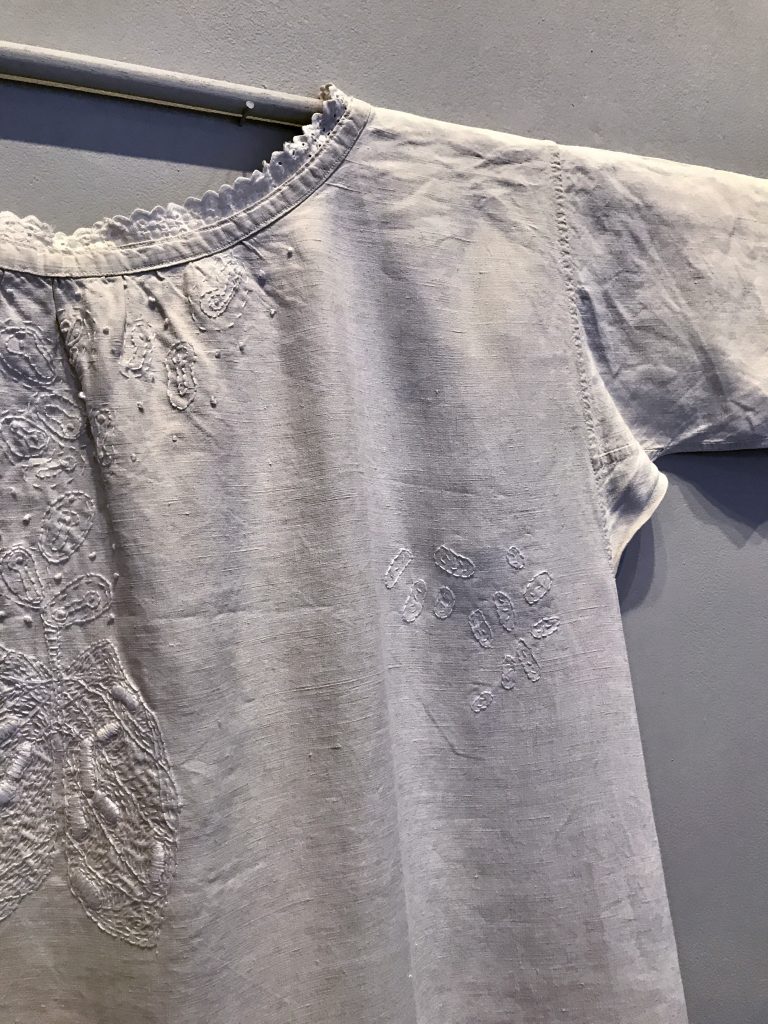
“Clean Linen” (2018) comprises an antique French nightgown which has been embroidered by the artist with images of the bacteria that cause Plague, tuberculosis, scarlet fever and diphtheria and invisibly impregnated with the extracted DNA of those sublime organisms. In the 17th Century (and later) it was not common practice to wash the body as people believed washing their linen clothes was sufficient (an idea that seems to have originated in France) and that ‘linen washed the skin through humoral regulation’.
This was related to the belief that clothing spread disease, which arose around the time of the Great Plague. Clean linen was specifically used to express cleanliness and respectability even for poorer people who rarely washed their bodies. Linen fibres become stronger when wet and are not damaged by washing, unlike silk and wool.
The Yersinia pestis (Plague), Mycobacterium tuberculosis (TB), Corynebacterium diphtheriae (diphtheria) and Streptococcus pyogenes (scarlet fever) DNA was extracted by the artist and her collaborators at the National Collection of Type Cultures at the UK Health Security Agency (formerly Public Health England) and Modernising Medical Microbiology.
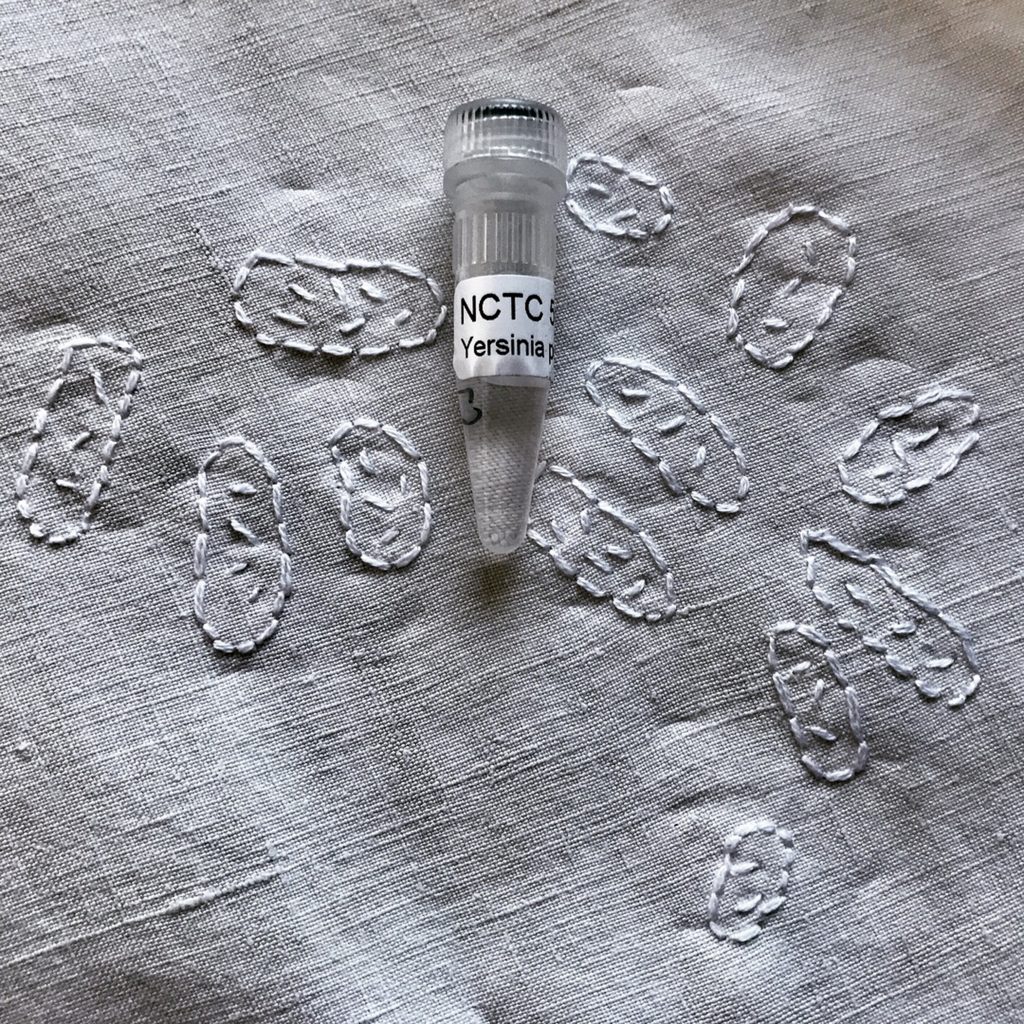
They are studying these bacteria in the lab using a technique called whole genome sequencing to learn more about them and help fight disease. The DNA is sterile and contains no infective elements but the idea of its presence brings about a sense of unease.
Clean Linen Past Exhibitions
From the Field at R- Space, Lisburn, Norther Ireland. As part of the 1st International Linen Biennale curated by Robert Martin. 1st August – 7th September 2018.
ReShape at MU Artspace in Eindhoven, Netherlands. Curated by Angelique Spaninks and William Myers. 30th November 2018 until 10th March 2019
6th Guangzhou Triennial “As We May Think Feedforward” at Guangdong Museum of Art, Guangzhou, China curated by Angelique Spaninks. 21st December 2018 and 10th March 2019.
“Children of Prometheus” at NeMe in Limassol, Cyprus. Curated by Marc Garrett (Furtherfield). 11th October – 20th December 2019.
Body and Mind: Seen and Unseen at The National Centre for Craft and Design in Sleaford, UK. 1st February – 6th September 2020.
“Collateral Effects” a solo exhibition of works by Anna Dumitriu, at the North Wall in Oxford, UK, from 5th to 29th October 2022.
The Art and Science of Linen
“The Art and Science of Linen” (2011) is a video art work created in close collaboration with international artist Alex May and microbiologist Dr John Paul, now held in the permanent collection of The Irish Linen Centre and Lisburn Museum in Northern Ireland. The work looks at the whole ecology of linen production from the bacteria used to break down the flax in retting tanks to the industrial production of linen and its cultural importance.
The video focusses strongly on textures of antique linen textiles, flax flowers, linen production methods (rural and industrial) and the beneficial microbes that help in its production. Dumitriu has created a number of works influenced by textile production processes in the Industrial Revolution and the jacquard looms used to create linen damask were of particular interest. The piece Includes images and footage taken at The Irish Linen Centre and Lisburn Museum and McConville’s Flax Mill & Museum where these historical processes can be seen in operation.
Art and Science of Linen Exhibitions
“The Art and Science of Linen” was first exhibited at The Irish Linen Centre and Lisburn Museum and R-Space Gallery in Northern Ireland in May – July 2011 and is now held in the permanent collection of the Irish Linen Centre and Lisburn Museum.
“Gone Viral: Medical Science and Contemporary Textile Art,” Marion Art Gallery, Rockefeller Art Center, SUNY Fredonia, New York in March- April 2013.
Design Matters at 5th Base Gallery, Brick Lane, London, curated by Fay Morrow, 31st March – 2nd April 2014, and it is part of the touring exhibition.
BioArt and Bacteria at the History of Science Museum in Oxford. 28th September 2017 and 18th March 2018.
From the Field at R- Space, Lisburn, Norther Ireland. As part of the 1st International Linen Biennale. 1st August – 7th September 2018.
BioArt and Bacteria at The Esther Klein Gallery and the Science Center in Philadelphia, USA. 18th October – 24th of November 2018.
BioArt and Bacteria at Eden Project, Cornwall, UK. 30th March – 1st June 2019.
“BioArt Alchemy” at Spazju Kreattiv in Malta, 16th September 2022 – 30th October 2022.
From the Field Exhibition Reviews
Linen and Bacteria: The Hidden History of Microbiology by Clara Rodríguez Fernández on Labiotech (EU), August 2018.
ON VIEW: From The Field by Anna Dumitriu by Julia Buntaine on SciArt Magazine (USA), August 2018.
